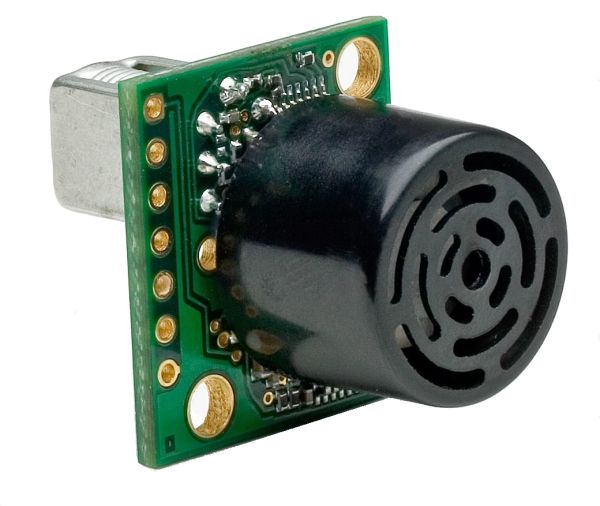The PIC sonar range finder works by transmitting a short pulse of sound at a frequency inaudible to the ear (ultrasonic sound or ultrasound).
Afterwards the microcontroller listens for an echo.
The time from transmission to echo reception lets you calculate the distance from the object.
PIC Sonar Specification
| Range | ~5cm – 300cm |
| Accuracy | +/-3cm |
| Transducer frequency | 40kHz |
| nternal oscillator frequency | 4MHz |
The project uses 5 standard transistors to receive and transmit the ultrasound and a comparator to set the threshold echo detection level – so there are no special components other than the microcontroller.
The ultrasonic transducers are standard 40kHz types.
Note that the internal oscillator of the PIC micro is used and this saves two pins – that can be used for normal I/O,
You can recompile the pic sonar project files if you want examine code operation (using the built in simulator) or change the source code. Note the hex file is contained in the download.
How the PIC Sonar rangefinder works
Since the speed of sound is constant through air measuring the echo reflection time lets you calculate the distance to the object using the DST equation :
Distance = (s * t)/2 (in metres)
You need to divide by 2 as the distance is the round trip distance i.e. from transmitter to object and back again.
Where:
| s [m/s] | the speed of sound in air |
| t [s] | the round trip echo time. |
Some delay times:
| Round trip echo time | Distance |
| t = 588us | 10cm |
| t = 5.8ms | 1m |
Note: The speed of sound in air is more or less constant at 330m/s (@ 0ºC) – it varies mainly with temperature (~340m/s @ 20ºC). In this project I am using a value of 340m/s i.e. it is assumed that the project is used indoors. You can change it to whatever you like by modifying the code.
You can get ultrasonic transducers optimized for 25kHz, 32kHz, 40kHz or wide bandwidth transducers. This project uses a 40kHz transducer but it will still work with the others if you make simple changes to the software (where it generates the 40kz signal). The receiver and generator circuits will work as they are.
Note: If you use a different transducer you must change the software to generate the correct frequency for the transducer as they only work at their specific operating frequency.
The 40kz signal is easily generated by the microcontroller but detection requires a sensitive amplifier. I have used a three transistor amplifier for the receiver.
This is followed by a peak detector and comparator which sets the sensitivity threshold so that false reflections (weaker signals) are ignored.
CCP – Capture mode
This project makes use of the CCP module (in its capture mode) to accurately measure the signal reception time at the CCP port pin. When a signal triggers the CCP module the value of timer 1 is stored in a CCP register (or captured).
If you store the value of timer 1 and then enable the CCP after transmitting an ultrasound pulse the CCP will trigger when the comparator activates i.e. as soon as an ultrasonic echo is received.
Subtracting the stored value from the CCP register value gives the time delay in machine cycles. Since the project uses a 4MHz main clock then the time delay will be measured in micro-seconds.
For more detail: Sonar range finder using PIC16F88 Microcontroller

